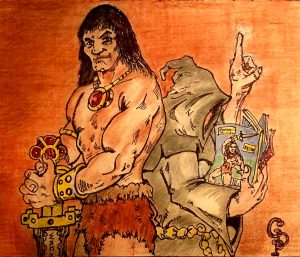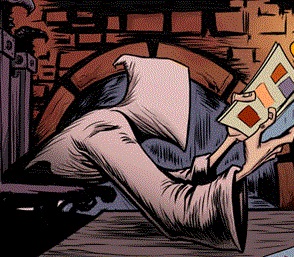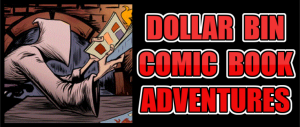
“Conan saves a woman and her mute companion but soon learns they are not without resources of their own. Escorted to a land above the clouds by a princess on winged pegasi, the Cimmerian will soon come face to face with the ‘goddess’ who protects them and who allows them to live in their world high above the earth.”
(EDITOR’S NOTE: Welcome to The Classic Conan Countdown, a series of reviews focusing on the original 275 issues of Marvel Comics’ Conan the Barbarian, which were published from 1970 to 1993. This is a review of Conan the Barbarian (Vol. 1) #121.)
By BOB FREEMAN — Paint Monk’s Library Writer
“It was TOTALLY INTIMIDATING following Roy Thomas on CONAN. I had such incredible respect for his work on that book (and everything else he did) that I was like a deer in the headlights, measuring every word, wondering if it was Thomasworthy!”
– J.M. DeMatteis
Conan works best not as a fantasy, but as a force of nature present in the genre that was given birth by his creator — sword and sorcery.
What’s the difference?
The wiki definition of fantasy literature is literature set in an imaginary universe, often but not always without any locations, events, or people from the real world. Magic, the supernatural, and magical creatures are common in many of these imaginary worlds. It is a story that children and adults can read.
All well and good.
As for sword and sorcery, the dictionary definition calls it, a genre of fiction characterized by heroic adventures and elements of fantasy. The wiki response takes this a bit further, calling it a subgenre of fantasy characterized by sword-wielding heroes engaged in exciting and violent adventures.
For me, the best sword and sorcery strays far and wide from more whimsical settings, and I think that may be where JM DeMatteis gets into trouble. DeMatteis has a tremendous imagination, but he leans heavily on the side of whimsy and high fantasy, whereas Conan’s element shines brightest in street-level grim and gritty.
Conan tales are intelligent without being cerebral. They are visceral and primordial, kinetic, and lustful… Sometimes a great writer is an ill-fit, but I do appreciate the effort.
Review: Conan the Barbarian (Vol. 1) #121

Conan strolls through the city with a pair of Korshemish prostitutes when they come upon a gang of bandits attacking a woman and her towering companion. Conan enters the fray, easily dispatching the villains. Conan is introduced to Prem, and her mute brother Atreah. The mute thanks Conan for his assistance, but Prem says it was unnecessary as they could have handled the brigands on their own, proving so when she calls forth sentries astride pegasi.
Prem invites Conan to fly with them, and although hesitant to interact with this sorcery, givens in and rides with them to the floating city of Mreead-Za.

The pegasi land, where they are welcomed by Prem’s father, King Pragma. Princess Prem desires to keep the Cimmerian as her own, so the king uses magic to render Conan unconscious. When he awakens, Conan has no memory of his former life, believing his name is Kalna-Faker, betrothed to Prem.
Conan is led through the city as Prem “reminds” him of how their stone-age ancestors were raised to the clouds by a goddess. He is accepted by all he meets, but when he enters the sparring arena, his barbarian nature is not so easily subdued by the magics that have clouded his mind.
Later that evening, they don black robes and Prem takes Conan into a ritual chamber where Atreah is bound to a sacrificial altar. Conan is uneasy as the ritual proceeds. Prem explains that Atreah has escaped before, but then a gust of wind blows through the chamber and Atreah disappears. Conan becomes enraged, demanding the wizard tell him what has become of the mute. The Cimmerian is told to seek Atreah by following the Road of Black Jade.

Conan secures a black pegasus and takes to the sky, riding through black smoke for days until he come to a volcano, the home of the goddess that granted them paradise. He makes his descent into the depths of the volcano, taunted by the goddess’ face in the lava. Conan sees giant bug-like creatures carrying Atreah and follows after them.
Conan attacks, hoping to rescue the mute, but the goddess emerges from the fiery pit, lashing out with her tentacles. Conan strikes true into the goddess’ heart and she falls back into the lava as the Cimmerian’s memories are restored.
He collects Atreah and they take flight, but the people of Mreead-Za are devolving as the city crumbles around them. Conan and Atreah return to earth just as the black pegasus disintegrates like everything else the goddess had fashioned.

CAPSULE REVIEW: This is one of those instances where Conan is shoe-horned into a great story that he has no business being a part of. It just doesn’t feel like a Conan yarn, because, quite frankly, it isn’t. It is a great fantasy tale, however, and I respect what DeMatteis was trying to do here. It just rings false for the Hyborian Age and Conan in particular.
As for the art, here we see Bob McLeod embellishing John Buscema’s pencils. McLeod has always been hit or miss with me, but in this instance, I find the art quite enjoyable. I suspect Buscema turned in tighter pencils for McLeod to work with.
I’d rate this issue 6.75 out of 10 Skulls of My Enemies.
—Alba Gu Brath
Bob Freeeman, theOccult Detective


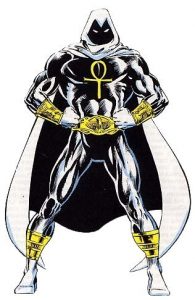




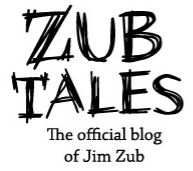

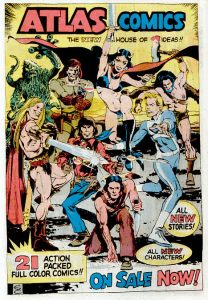

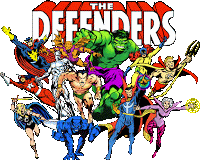


 Posted in
Posted in 